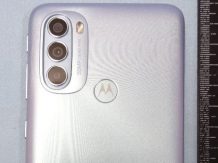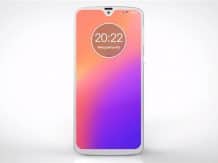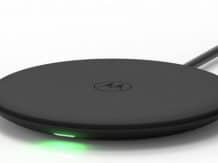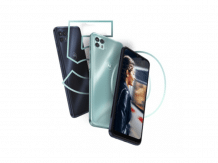I do not hide that I always try to look for even the smallest flaws of the tested products, but as for Motorola’s anger, it makes it difficult for me from her first smartphone, which I had the pleasure to review. Will it be the same with the Moto G6 Plus model?
You have to appreciate design!
Say what you want, but it’s really hard to disagree that it’s the appearance that plays the biggest role in a smartphone. At least at the beginning, because with time we get bored and we start to pay attention to the slightly more practical aspects of the new purchase. Nowadays, however, we have to go to great lengths to surprise our friends with a new smartphone, which I felt for myself during several tests. Most of the comments boiled down to something like “oh, another fake iPhone”, which is why I liked Motorola, which has long stuck to its usual style. It just so happens that this stubbornness in following its ideals has made Apple successful on a global scale. What can I say, nowadays the vast majority of smartphones look very similar or even identical, so choosing Motorola, we are a kind of modern hipsters. Hipsters who, however, appreciate well-designed products without unnecessary excess of form over content. And as you probably guessed, Moto G6 Plus is such a product.
In the set with this model, we get traditional equipment (charger, USB type C cable, key for the SIM and microSD card tray and three small information books) supplemented with a silicone case, which is a requirement for the slippery glass on the back and a terribly protruding section with two cameras and a dual flash. This entire section is by far the most iconic feature of Motorola smartphones. The G6 Plus is also distinguished by the lack of any note, which may even affect its possible choice. Unfortunately, the side frames and both beams (top and bottom) are really big and although it doesn’t bother me that much, I have to point out that the competition handled them better.
I’ve seen it somewhere before …
As I had the opportunity to test the Moto G6 model, I am referring you to it, because you will find much more information about the structure and individual functions in it. The differences between the two models are really small, although despite the price (~ PLN 350), the specification in the more expensive one (Plus) looks much better. This one is also noticeably larger (153.8 x 72.3 x 8.3mm vs 160 x 75.5 x 8mm), though retained the same weight (167 grams), providing itself a 0.2-inch larger display from the 409 pixels per inch. The arrangement of individual elements has also not changed, although I hoped in my heart that the Plus version would put on two speakers in stereo mode, although this single mono works great with native support for Dolby Audio. I also regret the lack of a notification LED, which is again replaced by the Moto display, an energy-saving overlay that displays minimalist information when motion is detected, like Samsung’s Always On Display.
The other differences are only subtle nuances that a typical smartphone user will not notice. Especially when it comes to the camera (night photos are still a pain), although Plus allows you to record in a noticeably better 4K resolution, while the cheaper one can only handle Full HD in 60 frames. It is a pity that the software stabilization, which is available at a maximum of 1080p, did not follow the resolution increase. In turn, the additional 200 mAh in the battery (3200 vs 3000 mAh) is imperceptible at all, which is rather understandable, because a more powerful specification translates into energy consumption. However, this does not change the fact that the G6 Plus can withstand almost 10 hours of traditional phone use in mixed mode, so you do not have to worry about whether you have enough battery for a whole day of fun. Even if you go crazy playing demanding titles for several hours in a row, the included 15W charger and support for Turbo Power charging will provide you with at least 80% power after 60 minutes.
What’s all the shout about?
So let’s take a look at the most important change in the Moto G6 Plus compared to the Moto G6, which is what sits under the hood. All components were improved, because the SoC Qualcomm Snapdragon 450 was replaced by the Qualcomm Snapdragon 630 with a 400 MHz more efficient central processor and a better graphics chip (Adreno 508 vs 506). The RAM deck was also improved, increasing it from 3 GB to 4 GB, while the mass one gained an additional 32 GB (64 GB in total). That’s it, at least in theory, because in practice a better specification is noticeable only with a really solid load on the smartphone and playing advanced productions. Especially in the mobile PUBG, which was smoother on the Moto G6 Plus at the highest possible settings.
A small curiosity is also the fact that the USB-C connector does not offer full transfer speed, which is due to the operation on a USB 2.0 controller. Maybe it’s not a big drawback, but it’s a pity that the producer himself doesn’t boast about it. In turn, this is how the basic system overlay looks like with several settings tabs:
Summary
Despite the unhealthy overcrowding of the market with smartphones, the Moto G6 Plus still presents itself as one of the most interesting choices up to PLN 1,200, which has something to offer that the competition does not always care about. What I mean here is solid workmanship (the glass pane does its job), characteristic and unique design, high efficiency, no notch (although I regret the size of the frames), good quality components and unusual accessories.
At the same time, I would like to remind you to read the previous Moto G6 test, where I went deeper into the details of the software and individual functions, and I have nothing else to do but to apply appropriate badges to this Motorola proposal:
All the above photos were taken with the Wiko View 2 Pro phone.
















